Subclass: Theria
Infraclass: Metatheria
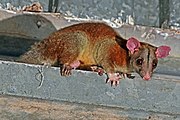
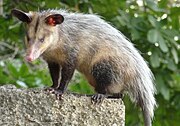


Order: Didelphimorphia (common opossums)
Didelphimorphia is the order of common opossums of the Western Hemisphere. Opossums probably diverged from the basic South American marsupials in the late Cretaceous or early Paleocene. They are small to medium-sized marsupials, about the size of a large house cat, with a long snout and prehensile tail.
- Family: Didelphidae (American opossums)
- Subfamily: Caluromyinae
- Genus: Caluromys
- Derby's woolly opossum, C. derbianusLC
- Genus: Caluromys
- Subfamily: Didelphinae
- Genus: Chironectes
- Water opossum, C. minimusLC
- Genus: Didelphis
- Common opossum, D. marsupialisLC
- Virginia opossum, D. virginianaLC
- Genus: Marmosa
- Mexican mouse opossum, M. mexicanaLC
- Genus: Metachirus
- Brown four-eyed opossum, M. nudicaudatusLC
- Genus: Philander
- Gray four-eyed opossum, P. opossumLC
- Genus: Tlacuatzin
- Grayish mouse opossum, T. canescensLC
- Genus: Chironectes
- Subfamily: Caluromyinae
Infraclass: Eutheria
Order: Sirenia (manatees and dugongs)

Sirenia is an order of fully aquatic, herbivorous mammals that inhabit rivers, estuaries, coastal marine waters, swamps, and marine wetlands. All four species are endangered. They evolved about 50 million years ago, and their closest living relatives are elephants. Manatees are the only extant afrotherians in the Americas. However, a number proboscid species, some of which survived until the arrival of Paleo-Indians, once inhabited the region. Mammoths, mastodons and gomphotheres all formerly lived in Mexico. [4] [5]
- Family: Trichechidae
- Genus: Trichechus
- West Indian manatee, T. manatusVU
- Genus: Trichechus
Order: Cingulata (armadillos)
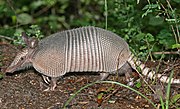
Armadillos are small mammals with a bony armored shell. Two of twenty-one extant species are present in Mexico; the remainder are only found in South America, where they originated. Their much larger relatives, the pampatheres and glyptodonts, once lived in North and South America but went extinct following the appearance of humans.
- Family: Dasypodidae (long-nosed armadillos)
- Subfamily: Dasypodinae
- Genus: Dasypus
- Nine-banded armadillo, D. novemcinctusLC
- Genus: Dasypus
- Subfamily: Dasypodinae
- Family: Chlamyphoridae (armadillos)
- Subfamily: Tolypeutinae
- Genus: Cabassous
- Northern naked-tailed armadillo, C. centralisDD
- Genus: Cabassous
- Subfamily: Tolypeutinae
Order: Pilosa (anteaters, sloths and tamanduas)

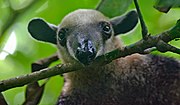
The order Pilosa is extant only in the Americas and includes the anteaters, sloths, and tamanduas. Their ancestral home is South America. Numerous ground sloths, some of which reached the size of elephants, were once present in both North and South America, as well as on the Antilles, but all went extinct following the arrival of humans.
- Suborder: Vermilingua
- Family: Cyclopedidae
- Genus: Cyclopes
- Common silky anteater, C. didactylusLC
- Central American silky anteater, C. dorsalisNE
- Genus: Cyclopes
- Family: Myrmecophagidae (American anteaters)
- Genus: Tamandua
- Northern tamandua, T. mexicanaLC
- Genus: Tamandua
- Family: Cyclopedidae
Order: Primates
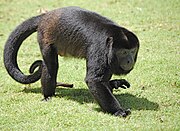

The order Primates includes the lemurs, monkeys, and apes, with the latter category including humans. It is divided into four main groupings: strepsirrhines, tarsiers, monkeys of the New World (parvorder Platyrrhini), and monkeys and apes of the Old World. Mexico's 2 genera of nonhuman primates compares to 6 in Central America, 20 in South America, 15 in Madagascar, 23 in Africa and 19 in Asia. Mexican and Central American monkeys are recent immigrants from South America, where their ancestors arrived after rafting over from Africa roughly 25 million years ago. [6] Southeastern Mexico is the northernmost limit of the distribution of New World monkeys, which are restricted to tropical rainforest habitat.
- Suborder: Haplorrhini
- Infraorder: Simiiformes
- Parvorder: Platyrrhini
- Family: Atelidae
- Subfamily: Alouattinae
- Genus: Alouatta
- Mantled howler, A. palliataLC
- Guatemalan black howler, A. pigraEN
- Genus: Alouatta
- Subfamily: Atelinae
- Genus: Ateles
- Geoffroy's spider monkey, A. geoffroyiEN
- Genus: Ateles
- Subfamily: Alouattinae
- Family: Atelidae
- Parvorder: Platyrrhini
- Infraorder: Simiiformes
Order: Rodentia (rodents)
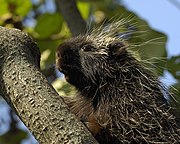





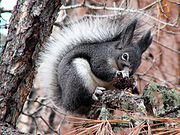
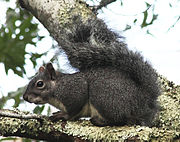

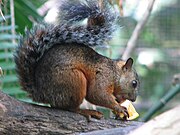
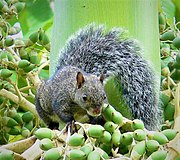









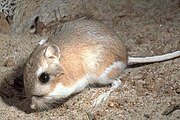


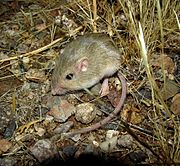







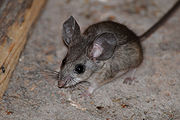
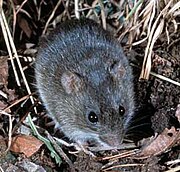
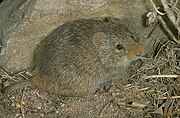
Rodents make up the largest order of mammals, with over 40% of mammalian species. They have two incisors in the upper and lower jaw which grow continually and must be kept short by gnawing. Most rodents are small, although the capybara can weigh up to 45 kg (99 lb). According to the IUCN listing, Mexico has more rodent species (236 as of April 2011) than any other country in the world (Brazil is second with 222). Of Mexico's rodents, 2% are caviomorphs, 14.5% are sciurids, 25.5% are castorimorphs and 58% are cricetids. This distribution is fairly similar to that of the remainder of North America (although sciurids are relatively twice as abundant to the north, at the expense of cricetids), but is very different from that of South America, where the corresponding figures are 36%, 3%, 1% and 60%. Of Mexico's cricetids, 17% are sigmodontine, while the figure for South America is 99.5%. [n 3] Mexico's caviomorphs are recent immigrants from South America, where their ancestors washed ashore after rafting across the Atlantic from Africa about 40–45 million years ago. [6] [7] Conversely, South America's sciurids, castorimorphs and cricetids are recent immigrants from Central America (with sigmodontines getting a head start on the others).
- Suborder: Hystricomorpha
- Family: Erethizontidae (New World porcupines)
- Subfamily: Erethizontinae
- Genus: Erethizon
- North American porcupine, E. dorsatumLC
- Genus: Coendou
- Mexican hairy dwarf porcupine, Coendou mexicanusLC
- Genus: Erethizon
- Subfamily: Erethizontinae
- Family: Dasyproctidae (agoutis and pacas)
- Genus: Dasyprocta
- Mexican agouti, Dasyprocta mexicanaCR
- Central American agouti, Dasyprocta punctataLC
- Genus: Dasyprocta
- Family: Cuniculidae
- Genus: Cuniculus
- Lowland paca, Cuniculus pacaLC
- Genus: Cuniculus
- Family: Erethizontidae (New World porcupines)
- Suborder: Sciuromorpha
- Family: Sciuridae (squirrels)
- Subfamily: Sciurinae
- Tribe: Pteromyini
- Genus: Glaucomys
- Southern flying squirrel, Glaucomys volansLC
- Genus: Glaucomys
- Tribe: Sciurini
- Genus: Sciurus
- Abert's squirrel, Sciurus abertiLC
- Allen's squirrel, Sciurus alleniLC
- Arizona gray squirrel, Sciurus arizonensisDD
- Mexican gray squirrel, Sciurus aureogasterLC
- Collie's squirrel, Sciurus colliaeiLC
- Deppe's squirrel, Sciurus deppeiLC
- Western gray squirrel, Sciurus griseusLC
- Mexican fox squirrel, Sciurus nayaritensisLC
- Fox squirrel, Sciurus nigerLC
- Peters's squirrel, Sciurus oculatusLC
- Variegated squirrel, Sciurus variegatoidesLC
- Yucatan squirrel, Sciurus yucatanensisLC
- Genus: Tamiasciurus
- Douglas squirrel, Tamiasciurus douglasiiLC
- Mearns's squirrel, T. d. mearnsiEN
- Douglas squirrel, Tamiasciurus douglasiiLC
- Genus: Sciurus
- Tribe: Pteromyini
- Subfamily: Xerinae
- Tribe: Marmotini
- Genus: Ammospermophilus
- Harris's antelope squirrel, Ammospermophilus harrisiiLC
- Espíritu Santo antelope squirrel, Ammospermophilus insularisNE
- Texas antelope squirrel, Ammospermophilus interpresLC
- White-tailed antelope squirrel, Ammospermophilus leucurusLC
- Genus: Cynomys
- Black-tailed prairie dog, Cynomys ludovicianusLC
- Mexican prairie dog, Cynomys mexicanusEN
- Genus: Neotamias
- Buller's chipmunk, Neotamias bulleriVU
- Cliff chipmunk, Neotamias dorsalisLC
- Durango chipmunk, Neotamias durangaeLC
- Merriam's chipmunk, Neotamias merriamiLC
- California chipmunk, Neotamias obscurusLC
- Genus: Spermophilus
- Tropical ground squirrel, Spermophilus adocetusLC
- Ring-tailed ground squirrel, Spermophilus annulatusLC
- Baja California rock squirrel, Spermophilus atricapillusEN
- California ground squirrel, Spermophilus beecheyiLC
- Sierra Madre ground squirrel, Spermophilus madrensisNT
- Mexican ground squirrel, Spermophilus mexicanusLC
- Perote ground squirrel, Xerospermophilus perotensisEN
- Spotted ground squirrel, Spermophilus spilosomaLC
- Round-tailed ground squirrel, Spermophilus tereticaudusLC
- Rock squirrel, Spermophilus variegatusLC
- Genus: Ammospermophilus
- Tribe: Marmotini
- Subfamily: Sciurinae
- Family: Sciuridae (squirrels)
- Suborder: Castorimorpha
- Family: Castoridae (beavers)
- Genus: Castor
- American beaver, Castor canadensisLC
- Genus: Castor
- Family: Geomyidae
- Genus: Cratogeomys
- Yellow-faced pocket gopher, Cratogeomys castanopsLC
- Oriental Basin pocket gopher, Cratogeomys fulvescensLC
- Smoky pocket gopher, Cratogeomys fumosusLC
- Goldman's pocket gopher, Cratogeomys goldmaniLC
- Merriam's pocket gopher, Cratogeomys merriamiLC
- Perote pocket gopher, Cratogeomys perotensisLC
- Flat-headed pocket gopher, Cratogeomys planiceps LC
- Genus: Geomys
- Desert pocket gopher, Geomys arenariusNT
- Texas pocket gopher, Geomys personatusLC
- Tropical pocket gopher, Geomys tropicalisCR
- Genus: Orthogeomys
- Oaxacan pocket gopher, Orthogeomys cuniculusDD
- Giant pocket gopher, Orthogeomys grandisLC
- Hispid pocket gopher, Orthogeomys hispidusLC
- Big pocket gopher, Orthogeomys laniusCR
- Genus: Pappogeomys
- Alcorn's pocket gopher, Pappogeomys alcorniCR
- Buller's pocket gopher, Pappogeomys bulleriLC
- Genus: Thomomys
- Botta's pocket gopher, Thomomys bottaeLC
- Southern pocket gopher, Thomomys umbrinusLC
- Genus: Zygogeomys
- Michoacan pocket gopher, Zygogeomys trichopusEN
- Genus: Cratogeomys
- Family: Heteromyidae
- Subfamily: Dipodomyinae
- Genus: Dipodomys
- Agile kangaroo rat, Dipodomys agilisLC
- Gulf Coast kangaroo rat, Dipodomys compactusLC
- Desert kangaroo rat, Dipodomys desertiLC
- San Quintin kangaroo rat, Dipodomys gravipesCR
- San Jose Island kangaroo rat, Dipodomys insularisCR
- Margarita Island kangaroo rat, Dipodomys margaritaeCR
- Merriam's kangaroo rat, Dipodomys merriamiLC
- Nelson's kangaroo rat, Dipodomys nelsoniLC
- Ord's kangaroo rat, Dipodomys ordiiLC
- Phillips's kangaroo rat, Dipodomys phillipsiiLC
- Dulzura kangaroo rat, Dipodomys simulansLC
- Banner-tailed kangaroo rat, Dipodomys spectabilisNT
- Genus: Dipodomys
- Subfamily: Heteromyinae
- Genus: Heteromys
- Desmarest's spiny pocket mouse, Heteromys desmarestianusLC
- Gaumer's spiny pocket mouse, Heteromys gaumeriLC
- Mexican spiny pocket mouse, Heteromys irroratusLC
- Nelson's spiny pocket mouse, Heteromys nelsoniEN
- Painted spiny pocket mouse, Heteromys pictusLC
- Salvin's spiny pocket mouse, Heteromys salviniLC
- Jaliscan spiny pocket mouse, Heteromys spectabilisEN
- Genus: Heteromys
- Subfamily: Perognathinae
- Genus: Chaetodipus
- Little desert pocket mouse, Chaetodipus arenariusLC
- Narrow-skulled pocket mouse, Chaetodipus artusLC
- Bailey's pocket mouse, Chaetodipus baileyiLC
- California pocket mouse, Chaetodipus californicusLC
- Dalquest's pocket mouse, Chaetodipus dalquestiVU
- Chihuahuan pocket mouse, Chaetodipus eremicusLC
- San Diego pocket mouse, Chaetodipus fallaxLC
- Long-tailed pocket mouse, Chaetodipus formosusLC
- Goldman's pocket mouse, Chaetodipus goldmaniNT
- Hispid pocket mouse, Chaetodipus hispidusLC
- Rock pocket mouse, Chaetodipus intermediusLC
- Lined pocket mouse, Chaetodipus lineatusDD
- Nelson's pocket mouse, Chaetodipus nelsoniLC
- Desert pocket mouse, Chaetodipus penicillatusLC
- Sinaloan pocket mouse, Chaetodipus pernixLC
- Baja pocket mouse, Chaetodipus rudinorisLC
- Spiny pocket mouse, Chaetodipus spinatusLC
- Genus: Perognathus
- Arizona pocket mouse, Perognathus amplusLC
- Plains pocket mouse, Perognathus flavescensLC
- Silky pocket mouse, Perognathus flavusLC
- Little pocket mouse, Perognathus longimembrisLC
- Merriam's pocket mouse, Perognathus merriamiLC
- Genus: Chaetodipus
- Subfamily: Dipodomyinae
- Family: Castoridae (beavers)
- Suborder: Myomorpha
- Family: Cricetidae
- Subfamily: Arvicolinae
- Genus: Microtus
- California vole, Microtus californicusLC
- Guatemalan vole, Microtus guatemalensisNT
- Mexican vole, Microtus mexicanusLC
- Tarabundí vole, Microtus oaxacensisEN
- Western meadow vole, Microtus drummondiiNE extirpated
- Jalapan pine vole, Microtus quasiaterNT
- Zempoaltépec vole, Microtus umbrosusEN
- Genus: Ondatra
- Muskrat, Ondatra zibethicusLC
- Genus: Microtus
- Subfamily: Tylomyinae
- Genus: Nyctomys
- Sumichrast's vesper rat, Nyctomys sumichrastiLC
- Genus: Otonyctomys
- Hatt's vesper rat, Otonyctomys hattiLC
- Genus: Ototylomys
- Big-eared climbing rat, Ototylomys phyllotisLC
- Genus: Tylomys
- Chiapan climbing rat, Tylomys bullarisCR
- Peters's climbing rat, Tylomys nudicaudusLC
- Tumbala climbing rat, Tylomys tumbalensisCR
- Genus: Nyctomys
- Subfamily: Neotominae
- Genus: Baiomys
- Southern pygmy mouse, Baiomys musculusLC
- Northern pygmy mouse, Baiomys tayloriLC
- Genus: Habromys
- Chinanteco deer mouse, Habromys chinantecoCR
- Delicate deer mouse, Habromys delicatulusCR
- Ixtlán deer mouse, Habromys ixtlaniCR
- Zempoaltepec deer mouse, Habromys lepturusCR
- Crested-tailed deer mouse, Habromys lophurusNT
- Habromys schmidlyi CR
- Jico deer mouse, Habromys simulatusEN
- Genus: Hodomys
- Allen's wood rat, Hodomys alleniLC
- Genus: Megadontomys
- Oaxaca giant deer mouse, Megadontomys cryophilusEN
- Nelson's giant deer mouse, Megadontomys nelsoniEN
- Thomas's giant deer mouse, Megadontomys thomasiEN
- Genus: Nelsonia
- Goldman's diminutive woodrat, Nelsonia goldmaniEN
- Diminutive woodrat, Nelsonia neotomodonNT
- Genus: Neotoma
- White-throated woodrat, Neotoma albigulaLC
- Turner Island woodrat, N. b. varia
- Tamaulipan woodrat, Neotoma angustapalataEN
- Bryant's woodrat, Neotoma bryantiEN
- Anthony's woodrat, N. b. anthonyiEX
- Bunker's woodrat, N. b. bunkeriEX
- San Martin Island woodrat, N. b. martinensisEX
- Arizona woodrat, Neotoma deviaLC
- Dusky-footed woodrat, Neotoma fuscipesLC
- Goldman's woodrat, Neotoma goldmaniLC
- Desert woodrat, Neotoma lepidaLC
- White-toothed woodrat, Neotoma leucodonLC
- Angel de la Guarda woodrat, Neotoma insularisDD
- Big-eared woodrat, Neotoma macrotisLC
- Mexican woodrat, Neotoma mexicanaLC
- Southern plains woodrat, Neotoma micropusLC
- Nelson's woodrat, Neotoma nelsoniCR
- Bolaños woodrat, Neotoma palatinaVU
- Sonoran woodrat, Neotoma phenaxNT
- White-throated woodrat, Neotoma albigulaLC
- Genus: Neotomodon
- Mexican volcano mouse, Neotomodon alstoniLC
- Genus: Osgoodomys
- Michoacan deer mouse, Osgoodomys banderanusLC
- Genus: Peromyscus
- Aztec mouse, Peromyscus aztecusLC
- Orizaba deer mouse, Peromyscus beataeLC
- Brush mouse, Peromyscus boyliiLC
- Perote mouse, Peromyscus bullatusCR
- California mouse, Peromyscus californicusLC
- Burt's deer mouse, Peromyscus canicepsCR
- Canyon mouse, Peromyscus crinitusLC
- Dickey's deer mouse, Peromyscus dickeyiCR
- Zacatecan deer mouse, Peromyscus difficilisLC
- Cactus mouse, Peromyscus eremicusLC
- Eva's desert mouse, Peromyscus evaLC
- Northern Baja deer mouse, Peromyscus fraterculusLC
- Blackish deer mouse, Peromyscus furvusDD
- Osgood's mouse, Peromyscus gratusLC
- Angel Island mouse, Peromyscus guardiaCR
- Guatemalan deer mouse, Peromyscus guatemalensisLC
- Naked-eared deer mouse, Peromyscus gymnotisLC
- Hooper's mouse, Peromyscus hooperiLC
- Transvolcanic deer mouse, Peromyscus hylocetesLC
- San Lorenzo mouse, Peromyscus interparietalisCR
- White-footed mouse, Peromyscus leucopusLC
- Nimble-footed mouse, Peromyscus levipesLC
- Tres Marias Island mouse, Peromyscus madrensisEN
- Deer mouse, Peromyscus maniculatusLC
- Brown deer mouse, Peromyscus megalopsLC
- Puebla deer mouse, Peromyscus mekisturusCR
- Zempoaltepec, Peromyscus melanocarpusEN
- Plateau mouse, Peromyscus melanophrysLC
- Black-eared mouse, Peromyscus melanotisLC
- Black-tailed mouse, Peromyscus melanurusEN
- Mesquite mouse, Peromyscus merriamiLC
- Mexican deer mouse, Peromyscus mexicanusLC
- Northern rock mouse, Peromyscus nasutusLC
- El Carrizo deer mouse, Peromyscus ochraventerEN
- White-ankled mouse, Peromyscus pectoralisLC
- Pemberton's deer mouse, Peromyscus pembertoniEX
- Tawny deer mouse, Peromyscus perfulvusLC
- Chihuahuan mouse, Peromyscus poliusNT
- False canyon mouse, Peromyscus pseudocrinitusCR
- La Palma field mouse, Peromyscus sagaxDD
- Schmidly's deer mouse, Peromyscus schmidlyiLC
- Santa Cruz mouse, Peromyscus sejugisEN
- Nayarit mouse, Peromyscus simulusVU
- Slevin's mouse, Peromyscus sleviniCR
- Gleaning mouse, Peromyscus spicilegusLC
- San Esteban Island mouse, Peromyscus stephaniCR
- Pinyon mouse, Peromyscus trueiLC
- Winkelmann's mouse, Peromyscus winkelmanniEN
- Yucatan deer mouse, Peromyscus yucatanicusLC
- Chiapan deer mouse, Peromyscus zarhynchusVU
- Genus: Reithrodontomys
- Baker's small-toothed harvest mouse, Reithrodontomys bakeriEN
- Sonoran harvest mouse, Reithrodontomys burtiDD
- Volcano harvest mouse, Reithrodontomys chrysopsisLC
- Fulvous harvest mouse, Reithrodontomys fulvescensLC
- Slender harvest mouse, Reithrodontomys gracilisLC
- Hairy harvest mouse, Reithrodontomys hirsutusVU
- Western harvest mouse, Reithrodontomys megalotisLC
- Mexican harvest mouse, Reithrodontomys mexicanusLC
- Small-toothed harvest mouse, Reithrodontomys microdonLC
- Plains harvest mouse, Reithrodontomys montanusLC
- Cozumel harvest mouse, Reithrodontomys spectabilisCR
- Sumichrast's harvest mouse, Reithrodontomys sumichrastiLC
- Narrow-nosed harvest mouse, Reithrodontomys tenuirostrisVU
- Zacatecas harvest mouse, Reithrodontomys zacatecaeLC
- Genus: Scotinomys
- Alston's brown mouse, Scotinomys teguinaLC
- Genus: Xenomys
- Magdalena rat, Xenomys nelsoniEN
- Genus: Baiomys
- Subfamily: Sigmodontinae
- Genus: Handleyomys
- Alfaro's rice rat, Handleyomys alfaroiLC
- Chapman's rice rat, Handleyomys chapmaniLC
- Black-eared rice rat, Handleyomys melanotisLC
- Striped rice rat, Handleyomys rhabdopsVU
- Long-nosed rice rat, Handleyomys rostratusLC
- Cloud forest rice rat, Handleyomys saturatiorNT
- Genus: Oligoryzomys
- Fulvous pygmy rice rat, Oligoryzomys fulvescensLC
- Genus: Onychomys
- Chihuahuan grasshopper mouse, Onychomys arenicolaLC
- Northern grasshopper mouse, Onychomys leucogasterLC
- Southern grasshopper mouse, Onychomys torridusLC
- Genus: Oryzomys
- White-bellied rice rat, Oryzomys albiventer
- Coues' rice rat, Oryzomys couesiLC
- Nelson's rice rat, Oryzomys nelsoniEX
- Marsh rice rat, Oryzomys palustrisLC
- Lower California rice rat, Oryzomys peninsulae
- Genus: Rheomys
- Mexican water mouse, Rheomys mexicanusEN
- Thomas's water mouse, Rheomys thomasiNT
- Genus: Sigmodon
- Allen's cotton rat, Sigmodon alleniVU
- Arizona cotton rat, Sigmodon arizonaeLC
- Tawny-bellied cotton rat, Sigmodon fulviventerLC
- Southern cotton rat, Sigmodon hirsutusLC
- Hispid cotton rat, Sigmodon hispidusLC presence uncertain
- White-eared cotton rat, Sigmodon leucotisLC
- Jaliscan cotton rat, Sigmodon mascotensisLC
- Yellow-nosed cotton rat, Sigmodon ochrognathusLC
- Miahuatlán cotton rat, Sigmodon planifronsEN
- Toltec cotton rat, Sigmodon toltecusLC
- Genus: Handleyomys
- Subfamily: Arvicolinae
- Family: Cricetidae
Order: Lagomorpha (lagomorphs)

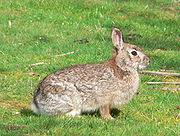
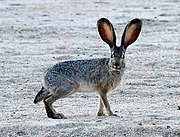
The lagomorphs comprise two families, Leporidae (hares and rabbits), and Ochotonidae (pikas). Though they can resemble rodents, and were classified as a superfamily in that order until the early 20th century, they have since been considered a separate order. They differ from rodents in a number of physical characteristics, such as having four incisors in the upper jaw rather than two. The endangered volcano rabbit of the Trans-Mexican Volcanic Belt is the world's second smallest rabbit. In North America, pikas are not found south of southern California and northern New Mexico.
- Family: Leporidae (rabbits, hares)
- Genus: Romerolagus
- Volcano rabbit, R. diaziEN
- Genus: Sylvilagus
- Desert cottontail, S. auduboniiLC
- Brush rabbit, S. bachmaniLC
- San Jose brush rabbit, S. b. mansuetusCR
- Mexican cottontail, S. cuniculariusLC
- Eastern cottontail, S. floridanusLC
- Central American tapetí, S. gabbiLC
- Tres Marias cottontail, S. graysoniEN
- Robust cottontail, S. holzneriVU presence uncertain
- Omilteme cottontail, S. insonusEN
- Genus: Lepus
- Antelope jackrabbit, L. alleniLC
- Tamaulipas jackrabbit, L. altamiraeNE
- Black-tailed jackrabbit, L. californicusLC
- White-sided jackrabbit, L. callotisNT
- Tehuantepec jackrabbit, L. flavigularisEN
- Black jackrabbit, L. insularisNT
- Genus: Romerolagus
Order: Eulipotyphla (shrews, hedgehogs, moles, and solenodons)


Eulipotyphlans are insectivorous mammals. Shrews and solenodons closely resemble mice, hedgehogs carry spines, while moles are stout-bodied burrowers. In the Americas, moles are not present south of the northernmost tier of Mexican states, where they are rare.
- Family: Soricidae (shrews)
- Subfamily: Soricinae
- Tribe: Blarinini
- Genus: Cryptotis
- Central Mexican broad-clawed shrew, Cryptotis alticolaDD
- Goldman's broad-clawed shrew, Cryptotis goldmani LC
- Goodwin's broad-clawed shrew, Cryptotis goodwini LC
- Guatemalan broad-clawed shrew, Cryptotis griseoventrisEN
- Big Mexican small-eared shrew, Cryptotis magnaVU
- Yucatan small-eared shrew, Cryptotis mayensis LC
- Merriam's small-eared shrew, Cryptotis merriami LC
- Mexican small-eared shrew, Cryptotis mexicana LC
- Nelson's small-eared shrew, Cryptotis nelsoniCR
- Grizzled Mexican small-eared shrew, Cryptotis obscura LC
- North American least shrew, Cryptotis parva LC
- Oaxacan broad-clawed shrew, Cryptotis peregrinaDD
- Phillips' small-eared shrew, Cryptotis phillipsiiVU
- Tropical small-eared shrew, Cryptotis tropicalisDD
- Genus: Cryptotis
- Tribe: Notiosoricini
- Genus: Megasorex
- Mexican shrew, Megasorex gigas LC
- Genus: Notiosorex
- Cockrum's gray shrew, Notiosorex cockrumi LC
- Crawford's gray shrew, Notiosorex crawfordi LC
- Large-eared gray shrew, Notiosorex evotis LC
- Villa's gray shrew, Notiosorex villaiVU
- Genus: Megasorex
- Tribe: Soricini
- Genus: Sorex
- Arizona shrew, Sorex arizonae LC
- Zacatecas shrew, Sorex emarginatus LC
- Sorex ixtlanensis DD
- Large-toothed shrew, Sorex macrodonVU
- Sorex mediopua LC
- Carmen Mountain shrew, Sorex milleriVU
- Montane shrew, Sorex monticolus LC
- Mexican long-tailed shrew, Sorex oreopolus LC
- Orizaba long-tailed shrew, Sorex orizabae LC
- Ornate shrew, Sorex ornatus LC
- Saussure's shrew, Sorex saussurei LC
- Sclater's shrew, Sorex sclateriCR
- San Cristobal shrew, Sorex stizodonCR
- Chestnut-bellied shrew, Sorex ventralis LC
- Veracruz shrew, Sorex veraecrucis LC
- Verapaz shrew, Sorex veraepacis LC
- Genus: Sorex
- Tribe: Blarinini
- Subfamily: Soricinae
- Family: Talpidae (moles)
- Subfamily: Scalopinae
- Tribe: Scalopini
- Genus: Scalopus
- Eastern mole, Scalopus aquaticus LC
- Genus: Scapanus
- Southern broad-footed mole, Scapanus occultus
- Mexican mole, Scapanus anthonyi
- Genus: Scalopus
- Tribe: Scalopini
- Subfamily: Scalopinae
Order: Chiroptera (bats)



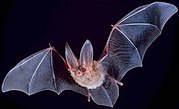



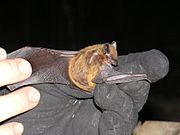
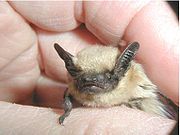








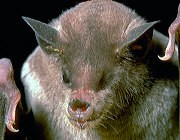
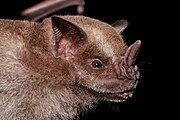


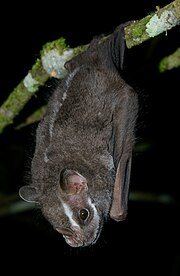

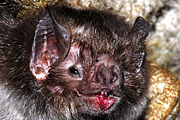


The bats' most distinguishing feature is that their forelimbs are developed as wings, making them the only mammals capable of flight. Bat species account for about 20% of all mammals.
- Family: Noctilionidae
- Genus: Noctilio
- Lesser bulldog bat, Noctilio albiventris LC
- Greater bulldog bat, Noctilio leporinus LC
- Genus: Noctilio
- Family: Vespertilionidae
- Subfamily: Myotinae
- Genus: Lasionycteris
- Silver-haired bat, Lasionycteris noctivagans LC
- Genus: Myotis
- Silver-tipped myotis, Myotis albescens LC
- Southwestern myotis, Myotis auriculus LC
- California myotis, Myotis californicus LC
- Western small-footed myotis, Myotis ciliolabrum LC
- Elegant myotis, Myotis elegans LC
- Long-eared myotis, Myotis evotis LC
- Findley's myotis, Myotis findleyiEN
- Cinnamon myotis, Myotis fortidens LC
- Hairy-legged myotis, Myotis keaysi LC
- Little brown bat, Myotis lucifugus LC
- Dark-nosed small-footed myotis, Myotis melanorhinus LC
- Black myotis, Myotis nigricans LC
- Arizona myotis, Myotis occultus LC
- Peninsular myotis, Myotis peninsularisEN
- Flat-headed myotis, Myotis planicepsEN
- Fringed myotis, Myotis thysanodes LC
- Cave myotis, Myotis velifer LC
- Fish-eating bat, Myotis vivesiVU
- Long-legged myotis, Myotis volans LC
- Yuma myotis, Myotis yumanensis LC
- Genus: Lasionycteris
- Subfamily: Vespertilioninae
- Genus: Antrozous
- Pallid bat, Antrozous pallidus LC
- Genus: Bauerus
- Van Gelder's bat, Bauerus dubiaquercusNT
- Genus: Corynorhinus
- Mexican big-eared bat, Corynorhinus mexicanusNT
- Townsend's big-eared bat, Corynorhinus townsendii LC
- Genus: Eptesicus
- Brazilian brown bat, Eptesicus brasiliensis LC
- Argentine brown bat, Eptesicus furinalis LC
- Big brown bat, Eptesicus fuscus LC
- Genus: Euderma
- Spotted bat, Euderma maculatum LC
- Genus: Idionycteris
- Allen's big-eared bat, Idionycteris phyllotis LC
- Genus: Lasiurus
- Desert red bat, Lasiurus blossevillii LC
- Eastern red bat, Lasiurus borealis LC
- Hoary bat, Lasiurus cinereus LC
- Southern yellow bat, Lasiurus ega LC
- Northern yellow bat, Lasiurus intermedius LC
- Seminole bat, Lasiurus seminolus LC
- Western yellow bat, Lasiurus xanthinus LC
- Genus: Nycticeius
- Evening bat, Nycticeius humeralis LC
- Genus: Pipistrellus
- Western pipistrelle, Pipistrellus hesperus LC
- Eastern pipistrelle, Pipistrellus subflavus LC
- Genus: Rhogeessa
- Yucatan yellow bat, Rhogeessa aeneus LC
- Allen's yellow bat, Rhogeessa alleni LC
- Genoways's yellow bat, Rhogeessa genowaysiEN
- Slender yellow bat, Rhogeessa gracilis LC
- Least yellow bat, Rhogeessa miraVU
- Little yellow bat, Rhogeessa parvula LC
- Black-winged little yellow bat, Rhogeessa tumida LC
- Genus: Antrozous
- Subfamily: Myotinae
- Family: Molossidae
- Genus: Cynomops
- Mexican dog-faced bat, Cynomops mexicanus LC
- Genus: Eumops
- Black bonneted bat, Eumops auripendulus LC
- Dwarf bonneted bat, Eumops bonariensis LC
- Wagner's bonneted bat, Eumops glaucinus LC
- Sanborn's bonneted bat, Eumops hansae LC
- Western mastiff bat, Eumops perotis LC
- Underwood's bonneted bat, Eumops underwoodi LC
- Genus: Molossus
- Aztec mastiff bat, Molossus aztecus LC
- Coiban mastiff bat, Molossus coibensis LC
- Velvety free-tailed bat, Molossus molossus LC
- Miller's mastiff bat, Molossus pretiosus LC
- Black mastiff bat, Molossus rufus LC
- Sinaloan mastiff bat, Molossus sinaloae LC
- Genus: Nyctinomops
- Peale's free-tailed bat, Nyctinomops aurispinosus LC
- Pocketed free-tailed bat, Nyctinomops femorosaccus LC
- Broad-eared bat, Nyctinomops laticaudatus LC
- Big free-tailed bat, Nyctinomops macrotis LC
- Genus: Promops
- Big crested mastiff bat, Promops centralis LC
- Genus: Tadarida
- Mexican free-tailed bat, Tadarida brasiliensis LC
- Genus: Cynomops
- Family: Emballonuridae
- Genus: Balantiopteryx
- Thomas's sac-winged bat, Balantiopteryx ioVU
- Gray sac-winged bat, Balantiopteryx plicata LC
- Genus: Centronycteris
- Thomas's shaggy bat, Centronycteris centralis LC
- Genus: Diclidurus
- Northern ghost bat, Diclidurus albus LC
- Genus: Peropteryx
- Greater dog-like bat, Peropteryx kappleri LC
- Lesser doglike bat, Peropteryx macrotis LC
- Genus: Rhynchonycteris
- Proboscis bat, Rhynchonycteris naso LC
- Genus: Saccopteryx
- Greater sac-winged bat, Saccopteryx bilineata LC
- Lesser sac-winged bat, Saccopteryx leptura LC
- Genus: Balantiopteryx
- Family: Mormoopidae
- Genus: Mormoops
- Ghost-faced bat, Mormoops megalophylla LC
- Genus: Pteronotus
- Davy's naked-backed bat, Pteronotus davyi LC
- Big naked-backed bat, Pteronotus gymnonotus LC
- Parnell's mustached bat, Pteronotus parnellii LC
- Wagner's mustached bat, Pteronotus personatus LC
- Genus: Mormoops
- Family: Phyllostomidae
- Subfamily: Phyllostominae
- Genus: Chrotopterus
- Big-eared woolly bat, Chrotopterus auritus LC
- Genus: Glyphonycteris
- Tricolored big-eared bat, Glyphonycteris sylvestris LC
- Genus: Lampronycteris
- Yellow-throated big-eared bat, Lampronycteris brachyotis LC
- Genus: Lonchorhina
- Tomes's sword-nosed bat, Lonchorhina aurita LC
- Genus: Lophostoma
- Pygmy round-eared bat, Lophostoma brasiliense LC
- Davis's round-eared bat, Lophostoma evotis LC
- Genus: Macrophyllum
- Long-legged bat, Macrophyllum macrophyllum LC
- Genus: Macrotus
- California leaf-nosed bat, Macrotus californicus LC
- Waterhouse's leaf-nosed bat, Macrotus waterhousii LC
- Genus: Micronycteris
- Common big-eared bat, Micronycteris microtis LC
- Schmidts's big-eared bat, Micronycteris schmidtorum LC
- Genus: Mimon
- Cozumelan golden bat, Mimon cozumelae LC
- Striped hairy-nosed bat, Mimon crenulatum LC
- Genus: Phylloderma
- Pale-faced bat, Phylloderma stenops LC
- Genus: Phyllostomus
- Pale spear-nosed bat, Phyllostomus discolor LC
- Genus: Tonatia
- Stripe-headed round-eared bat, Tonatia saurophila LC
- Genus: Trachops
- Fringe-lipped bat, Trachops cirrhosus LC
- Genus: Trinycteris
- Niceforo's big-eared bat, Trinycteris nicefori LC
- Genus: Vampyrum
- Spectral bat, Vampyrum spectrumNT
- Genus: Chrotopterus
- Subfamily: Glossophaginae
- Genus: Anoura
- Geoffroy's tailless bat, Anoura geoffroyi LC
- Genus: Choeroniscus
- Godman's long-tailed bat, Choeroniscus godmani LC
- Genus: Choeronycteris
- Mexican long-tongued bat, Choeronycteris mexicanaNT
- Genus: Glossophaga
- Commissaris's long-tongued bat, Glossophaga commissarisi LC
- Gray long-tongued bat, Glossophaga leachii LC
- Western long-tongued bat, Glossophaga morenoi LC
- Pallas's long-tongued bat, Glossophaga soricina LC
- Genus: Hylonycteris
- Underwood's long-tongued bat, Hylonycteris underwoodi LC
- Genus: Leptonycteris
- Greater long-nosed bat, Leptonycteris nivalisEN
- Lesser long-nosed bat, Leptonycteris yerbabuenaeVU
- Genus: Lichonycteris
- Dark long-tongued bat, Lichonycteris obscura LC
- Genus: Musonycteris
- Banana bat, Musonycteris harrisoniVU
- Genus: Anoura
- Subfamily: Carolliinae
- Genus: Carollia
- Seba's short-tailed bat, Carollia perspicillata LC
- Sowell's short-tailed bat, Carollia sowelli LC
- Gray short-tailed bat, Carollia subrufa LC
- Genus: Carollia
- Subfamily: Stenodermatinae
- Genus: Artibeus
- Hairy fruit-eating bat, Artibeus hirsutus LC
- Jamaican fruit bat, Artibeus jamaicensis LC
- Great fruit-eating bat, Artibeus lituratus LC
- Genus: Centurio
- Wrinkle-faced bat, Centurio senex LC
- Genus: Chiroderma
- Salvin's big-eyed bat, Chiroderma salvini LC
- Hairy big-eyed bat, Chiroderma villosum LC
- Genus: Dermanura
- Aztec fruit-eating bat, Dermanura azteca LC
- Pygmy fruit-eating bat, Dermanura phaeotis LC
- Toltec fruit-eating bat, Dermanura tolteca LC
- Thomas's fruit-eating bat, Dermanura watsoni LC
- Genus: Enchisthenes
- Velvety fruit-eating bat, Enchisthenes hartii LC
- Genus: Platyrrhinus
- Heller's broad-nosed bat, Platyrrhinus helleri LC
- Genus: Sturnira
- Little yellow-shouldered bat, Sturnira lilium LC
- Highland yellow-shouldered bat, Sturnira ludovici LC
- Genus: Uroderma
- Tent-making bat, Uroderma bilobatum LC
- Brown tent-making bat, Uroderma magnirostrum LC
- Genus: Vampyressa
- Northern little yellow-eared bat, Vampyressa thyone LC
- Genus: Vampyrodes
- Great stripe-faced bat, Vampyrodes caraccioli LC
- Genus: Artibeus
- Subfamily: Desmodontinae
- Genus: Desmodus
- Common vampire bat, Desmodus rotundus LC
- Genus: Diaemus
- White-winged vampire bat, Diaemus youngi LC
- Genus: Diphylla
- Hairy-legged vampire bat, Diphylla ecaudata LC
- Genus: Desmodus
- Subfamily: Phyllostominae
- Family: Natalidae
- Genus: Natalus
- Natalus lanatus LC
- Mexican greater funnel-eared bat, Natalus mexicanus LC
- Genus: Natalus
- Family: Thyropteridae
- Genus: Thyroptera
- Spix's disk-winged bat, Thyroptera tricolor LC
- Genus: Thyroptera
Order: Carnivora (carnivorans)






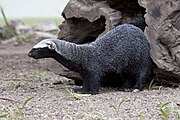
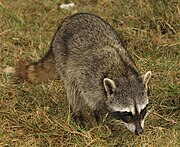


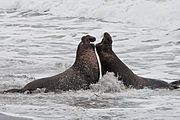

There are over 260 species of carnivorans, the majority of which feed primarily on meat. They have a characteristic skull shape and dentition. Mexico has more native mephitids than any other country, with two thirds of extant species being present. Only Costa Rica and Panama have more procyonid species (one more) than Mexico (it is tied with Colombia in this respect). Large extinct carnivorans that lived in the area prior to the coming of humans include the saber-toothed cat Smilodon fatalis , the scimitar cat Homotherium serum , American lions, American cheetahs, dire wolves and short-faced bears.
- Suborder: Feliformia
- Family: Felidae (cats)
- Subfamily: Felinae
- Genus: Herpailurus
- Jaguarundi, H. yagouaroundiLC
- Genus: Leopardus
- Genus: Lynx
- Bobcat, L. rufusLC
- Genus: Puma
- Cougar, P. concolorLC
- Genus: Herpailurus
- Subfamily: Pantherinae
- Subfamily: Felinae
- Family: Felidae (cats)
- Suborder: Caniformia
- Family: Canidae (dogs, foxes)
- Family: Ursidae (bears)
- Genus: Ursus
- American black bear, U. americanusLC
- Brown bear, U. arctosLC extirpated
- Mexican grizzly bear, U. a. horribilisEX
- Genus: Ursus
- Family: Mephitidae
- Genus: Conepatus
- American hog-nosed skunk, C. leuconotusLC
- Striped hog-nosed skunk, C. semistriatusLC
- Genus: Mephitis
- Hooded skunk, M. macrouraLC
- Striped skunk, M. mephitisLC
- Genus: Spilogale
- Southern spotted skunk, S. angustifronsLC
- Western spotted skunk, S. gracilisLC
- Eastern spotted skunk, S. putoriusLC
- Pygmy spotted skunk, S. pygmaeaVU
- Genus: Conepatus
- Family: Mustelidae (mustelids)
- Genus: Eira
- Tayra, E. barbaraLC
- Genus: Enhydra
- Sea otter, E. lutrisEN
- Genus: Galictis
- Greater grison, G. vittataLC
- Genus: Lontra
- North American river otter, L. canadensisLC presence uncertain
- Neotropical river otter, L. longicaudisNT
- Genus: Mustela
- Black-footed ferret, M. nigripesEN extirpated
- Genus: Neogale
- Long-tailed weasel, N. frenataLC
- Genus: Taxidea
- American badger, T. taxusLC
- Genus: Eira
- Family: Procyonidae (raccoons)
- Genus: Bassariscus
- Ringtail, B. astutusLC
- Cacomistle, B. sumichrastiLC
- Genus: Nasua
- White-nosed coati, N. naricaLC
- Cozumel Island coati, N. n. nelsoni
- White-nosed coati, N. naricaLC
- Genus: Potos
- Kinkajou, P. flavusLC
- Genus: Procyon
- Common raccoon, P. lotorLC
- Tres Marias raccoon, P. l. insularis
- Cozumel raccoon, P. pygmaeusCR
- Common raccoon, P. lotorLC
- Genus: Bassariscus
- Clade Pinnipedia (seals, sea lions and walruses)
- Family: Otariidae (eared seals, sea lions)
- Genus: Arctocephalus
- Galápagos fur seal, A. galapagoensisEN vagrant [8]
- Guadalupe fur seal, A. townsendiLC
- Genus: Callorhinus
- Northern fur seal, C. ursinusVU
- Genus: Zalophus
- California sea lion, Z. californianusLC
- Genus: Arctocephalus
- Family: Phocidae (earless seals)
- Genus: Mirounga
- Northern elephant seal, M. angustirostrisLC
- Southern elephant seal, M. leoninaLC vagrant [9]
- Genus: Neomonachus
- Caribbean monk seal, N. tropicalisEX
- Genus: Phoca
- Harbor seal, P. vitulinaLC
- Genus: Mirounga
- Family: Otariidae (eared seals, sea lions)
Order: Perissodactyla (odd-toed ungulates)

The odd-toed ungulates are browsing and grazing mammals. They are usually large to very large, and have relatively simple stomachs and a large middle toe. Tapirids were more widespread before humans appeared, formerly being present in temperate North America as well as the tropical regions they are found in today. Native equids once lived in the region, having evolved in North America over a period of 50 million years, but died out around the time of the first arrival of humans, along with at least one ungulate of South American origin, the notoungulate Mixotoxodon . Sequencing of collagen from a fossil of one recently extinct notoungulate has indicated that this order was closer to the perissodactyls than any extant mammal order. [10]
- Family: Equidae
- Genus: Equus
- Wild horse, Equus ferusEN extirpated
- Domestic horse, E. f. caballus introduced
- Wild horse, Equus ferusEN extirpated
- Genus: Equus
- Family: Tapiridae (tapirs)
- Genus: Tapirus
- Baird's tapir, T. bairdiiEN
- Genus: Tapirus
Order: Artiodactyla (even-toed ungulates and cetaceans)
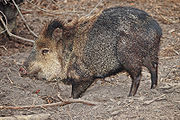




The even-toed ungulates are ungulates whose weight is borne about equally by the third and fourth toes, rather than mostly or entirely by the third as in perissodactyls. There are about 220 noncetacean artiodactyl species, including many that are of great economic importance to humans. All of Mexico's extant ungulates are of Nearctic origin. Prior to the arrival of humans, camelids, which evolved in North America, also lived in the region, as did additional antilocaprids (e.g., Capromeryx minor ).
- Family: Tayassuidae (peccaries)
- Genus: Dicotyles
- Collared peccary, D. tajacuLC
- Genus: Tayassu
- White-lipped peccary, T. pecariNT
- Genus: Dicotyles
- Family: Cervidae (deer)
- Subfamily: Cervinae
- Genus: Cervus
- Elk, C. canadensisLC extirpated
- Merriam's elk, C. c. merriamiEX
- Elk, C. canadensisLC extirpated
- Genus: Cervus
- Subfamily: Capreolinae
- Genus: Mazama
- Central American red brocket, M. temamaDD
- Genus: Odocoileus
- Mule deer, O. hemionusLC
- Yucatan brown brocket, O. pandoraVU
- White-tailed deer, O. virginianusLC
- Genus: Mazama
- Subfamily: Cervinae
- Family: Antilocapridae (pronghorn)
- Genus: Antilocapra
- Pronghorn, A. americanaLC reintroduced
- Mexican pronghorn, A. a. mexicanaEN
- Baja California pronghorn, A. a. peninsularisCR
- Sonoran pronghorn, A. a. sonoriensisEN
- Pronghorn, A. americanaLC reintroduced
- Genus: Antilocapra
- Family: Bovidae (cattle, antelope, sheep, goats)
- Subfamily: Bovinae
- Genus: Bison
- American bison, B. bisonNT reintroduced
- Plains bison, B. b. bison reintroduced
- American bison, B. bisonNT reintroduced
- Genus: Boselaphus
- Genus: Bison
- Subfamily: Caprinae
- Genus: Ovis
- Bighorn sheep, O. canadensisLC
- Desert bighorn sheep, O. c. nelsoniEN
- Bighorn sheep, O. canadensisLC
- Genus: Ovis
- Subfamily: Bovinae
Order: Cetacea (whales, dolphins and porpoises)












The order Cetacea includes whales, dolphins and porpoises. They are the mammals most fully adapted to aquatic life with a spindle-shaped nearly hairless body, protected by a thick layer of blubber, and forelimbs and tail modified to provide propulsion underwater. Their closest extant relatives are the hippos, which are artiodactyls, from which cetaceans descended; cetaceans are thus also artiodactyls. Lagoons on the coast of Baja California Sur provide calving grounds for the eastern Pacific population of gray whales. The vaquita of the northern Gulf of California is the world's smallest and most endangered cetacean.
- Parvorder: Mysticeti
- Family: Balaenopteridae
- Subfamily: Balaenopterinae
- Genus: Balaenoptera
- Northern minke whale, Balaenoptera acutorostrata LC
- Sei whale, Balaenoptera borealis EN
- Bryde's whale, Balaenoptera edeniDD critically endangered population in Gulf of Mexico
- Blue whale, Balaenoptera musculusEN
- Fin whale, Balaenoptera physalus
- Northern fin whale, B. p. physalusVU
- Genus: Balaenoptera
- Subfamily: Megapterinae
- Genus: Megaptera
- Humpback whale, Megaptera novaeangliae LC
- Genus: Megaptera
- Subfamily: Balaenopterinae
- Family: Eschrichtiidae
- Genus: Eschrichtius
- Gray whale, Eschrichtius robustus LC
- Genus: Eschrichtius
- Family: Balaenidae
- Genus: Eubalaena
- North Pacific right whale, Eubalaena japonicaCR extremely rare
- North Atlantic right whale, Eubalaena glacialisCR possibly seen historically [12]
- Genus: Eubalaena
- Family: Balaenopteridae
- Parvorder: Odontoceti
- Family: Physeteridae (sperm whales)
- Genus: Physeter
- Sperm whale, Physeter macrocephalusVU
- Genus: Physeter
- Family: Kogiidae
- Genus: Kogia
- Pygmy sperm whale, Kogia brevicepsDD
- Dwarf sperm whale, Kogia simaDD
- Genus: Kogia
- Family: Ziphidae
- Genus: Ziphius
- Cuvier's beaked whale, Ziphius cavirostris LC
- Genus: Berardius
- Baird's beaked whale, Berardius bairdiiDD
- Subfamily: Hyperoodontinae
- Genus: Indopacetus
- Tropical bottlenose whale, Indopacetus pacificusDD
- Genus: Mesoplodon
- Blainville's beaked whale, Mesoplodon densirostrisDD
- Gervais' beaked whale, Mesoplodon europaeusDD
- Ginkgo-toothed beaked whale, Mesoplodon ginkgodensDD
- Pygmy beaked whale, Mesoplodon peruvianusDD
- Genus: Indopacetus
- Genus: Ziphius
- Superfamily: Delphinoidea
- Family: Phocoenidae (porpoises)
- Genus: Phocoena
- Vaquita, P. sinusCR
- Genus: Phocoenoides
- Dall's porpoise, Phocoenoides dalli LC
- Genus: Phocoena
- Family: Delphinidae (marine dolphins)
- Genus: Steno
- Rough-toothed dolphin, Steno bredanensis LC
- Genus: Tursiops
- Bottlenose dolphin, Tursiops truncatus LC
- Genus: Stenella
- Pantropical spotted dolphin, Stenella attenuata LC
- Clymene dolphin, Stenella clymeneDD
- Striped dolphin, Stenella coeruleoalba LC
- Atlantic spotted dolphin, Stenella frontalisDD
- Spinner dolphin, Stenella longirostrisDD
- Genus: Delphinus
- Long-beaked common dolphin, Delphinus capensisDD
- Short-beaked common dolphin, Delphinus delphis LC
- Genus: Lagenodelphis
- Fraser's dolphin, Lagenodelphis hosei LC
- Genus: Lissodelphis
- Northern right whale dolphin, Lissodelphis borealis LC
- Genus: Sagmatias
- Pacific white-sided dolphin, Sagmatias obliquidens LC
- Genus: Grampus
- Risso's dolphin, Grampus griseus LC
- Genus: Peponocephala
- Melon-headed whale, Peponocephala electra LC
- Genus: Feresa
- Pygmy killer whale, Feresa attenuataDD
- Genus: Pseudorca
- False killer whale, Pseudorca crassidensDD
- Genus: Orcinus
- Orca, Orcinus orcaDD
- Genus: Globicephala
- Short-finned pilot whale, Globicephala macrorhynchusDD
- Genus: Steno
- Family: Phocoenidae (porpoises)
- Family: Physeteridae (sperm whales)